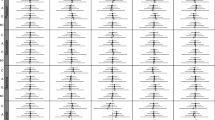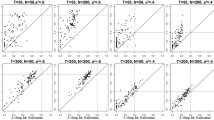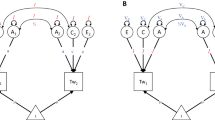Abstract
Observed differences in phenotypic means between groups such as parents and their offspring or male and female twins can be decomposed into genetic and environmental components. The decomposition is based on the assumption that the difference in phenotypic means is due to a difference in the location of the normal genetic and environmental distributions underlying the phenotypic individual differences. Differences between the groups in variance can be accommodated insofar as they are due to differences in unique variance or can be modeled using a scale parameter. The decomposition may be carried out in the standard analysis of genetic covariance structure using, for instance, LISREL. Illustrations are given using simulated data and twin data relating to blood pressure. Other possible applications are mentioned.
Similar content being viewed by others
References
Boomsma, D. I., and Molenaar, P. C. M. (1987). The genetic analysis of repeated measures. I. Simplex models.Behav. Genet. 17:111–123.
Boomsma, D. I., Molenaar, P. C. M., and Orlebeke, J. F. (1990). Estimation of individual genetic and environmental factor scores.Genet. Epidemiol. 7:83–91.
Browne, M. W. (1984). Asymptotically distribution-free methods for the analysis of covariance structures.Br. J. Math. Stat. Psychol. 37:62–83.
Dolan, C. V., Molenaar, P. C. M., and Boomsma, D. I. (1989). LISREL analysis of twin data with structured means.Behav. Genet. 17:51–62.
Dolan, C. V., Molenaar, P. C. M., and Boomsma, D. I. (1991). Simultaneous genetic analysis of longitudinal means and covariance structure in the simplex model using twin data.Behav. Genet. 21:49–65.
Eaves, L. J., Long, J., and Heath, A. C. (1986). A theory of developmental change in quantitative phenotypes applied to cognitive development.Behav. Genet. 16:143–162.
Grossman, M., and Bohren, B. B. (1985). Logistic growth curve of chickens: Heritability of parameters.J. of Hered. 76:459–462.
Heath, A. C., Eaves, L. J., and Martin, N. G. (1989). The genetic structure of personality. III. Multivariate genetic item analysis of the EPQ scales.Person. Individ. Diff. 10(8):877–888.
Heath, A. C., Neale, M. C., Hewitt, J. K., Eaves, L. J., and Fulker, D. W., (1989). Testing structural equation models for twin data using LISREL.Behav. Gen. 19:9–38.
Hewitt, J. K. (1990). Changes in genetic control learning, development, and aging. In Hahn, M. E., Hewitt, J. K., Henderson, N. D., and Benno, R. H. (eds.),Developmental Behavior Genetics: Neural, Biometrical and Evolutionary Approaches, Oxford University Press, Oxford.
Hewitt, J. K., Eaves, L. J., Mosteller, M., and Schieken, R. (1989). Can increases in mean heart rate during aerobic exercise be accounted for by scalar increments in the effects of genes that control individual differences.Behav. Genet. 19:763.
Jöreskog, K. G. and Sörbom, D. (1986).PreLis: A Preprocessor for LISREL, Scientific Software, Mooresville, USA.
Jöreskog, K. G., and Sörbom, D. (1988).LISREL VII: A Guide to the Program and Applications, SPSS, Chicago.
Mardia, K. V. (1980). Tests of univarite and multivariate normality. In Krishnaiah, P. R. (ed.),Handbook of Statistics, Vol. 1, North-Holland Publishing Company, Amsterdam, pp. 279–320.
Martin, N. G., and Eaves, L. J. (1977). The genetical analysis of covariance structures.Heredity 38:79–95.
Mather, K., and Jinks, J. L. (1977).Introduction to Biometrical Genetics, Chapman and Hall, London.
McArdle, J. J. (1986). Latent variable growth within behavior genetic models.Behav. Genet. 16:163–200.
McArdle, J. J., and Goldsmith, H. H. (1984). Structural equation modeling applied to the twin design: Comparative multivariate models of the WAIS.Behav. Genet. 14:609.
Muthén, B. (1989). Multi-group structural modelling with non-normal continuous variables.Br. J. Math. Stat. Psychol. 42:55–62.
Royston, J. P. (1985). The distribution of skewness and kurtosis.Appl. Stat. 34(1):87–94.
Sörbom, D. (1974). A general method for studying differences in factor means and factor structure between groups.Br. J. Math. Stat. Psychol. 27:229–239.
Sörbom, D. (1976). A statistical model for the measurement of change in true scores. In de Gruyter, D. N. M., and van der Kamp, L. J. T. (eds.),Advances in Psychological and Educational Measurement, J. Wiley and Sons, New York.
Sörbom, D. (1978). An alternative to the methodology for analysis of covariance.Psychometrica 43:381–396.
Vandenberg, S. G., and Falkner, F. (1965). Hereditary factors in human growth.Hum. Biol. 37:357–365.
Author information
Authors and Affiliations
Rights and permissions
About this article
Cite this article
Dolan, C.V., Molenaar, P.C.M. & Boomsma, D.I. Decomposition of multivariate phenotypic means in multigroup genetic covariance structure analysis. Behav Genet 22, 319–335 (1992). https://doi.org/10.1007/BF01066664
Received:
Accepted:
Issue Date:
DOI: https://doi.org/10.1007/BF01066664




